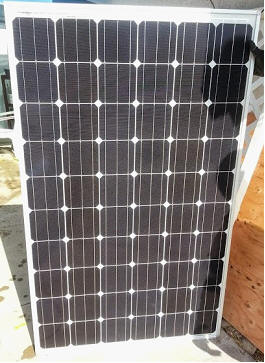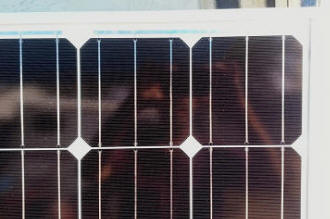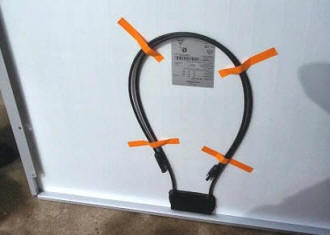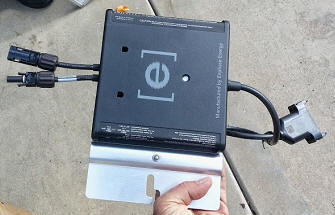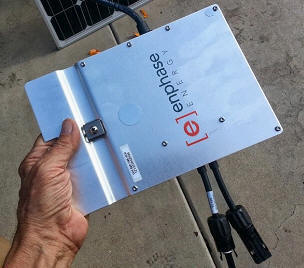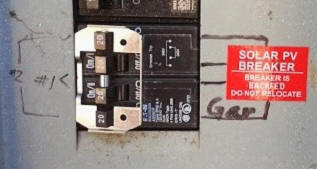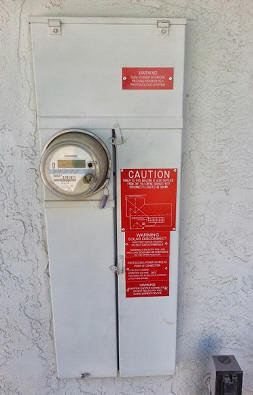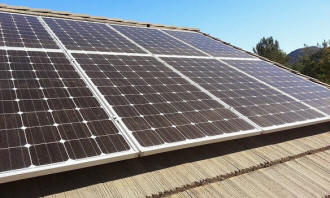Solace in Solar |
|
Sunshine Design Engineering Services RF test engineer Joe Cahak, owner of Sunshine Design Engineering Services, recently had a photovoltaic panel system installed on his southern California home. After much research and running through return on investment (RoI) calculations, he made the decision to invest in a state-of-the-art system by Semper Solaris in San Diego. If you have not looked into modern PV technology, you might be surprised - as was I - to learn that rather than all the panels feeding their DC outputs into a common AC inverter that handles phasing issues with the street service, instead each panel has its own inverter and phase matching circuit so everything simply feeds into a 2-pole circuit breaker. Doing so eliminates single point failures and allows graceful degradation if necessary rather than taking down the entire system. Joe has provided a very nicely done write-up on the system and its installation. See list of all of Joe's articles at bottom of page. Solace in Solar
Figure 1 - Solar World Panel Figure 2 - Solar Panel Grid and Corner Figure 3 - Solar Panel Rear Electric Connection By Joseph L. Cahak Copyright 2013 Sunshine Design Engineering Services I consider myself a conservative investor and also a practical environmentalist. I have watched alternative energy and especially solar for many years and closely looked at the technology, the lifetime, the efficiency and the economics of various incarnations of solar systems. I also looked at methane and wind power as possibilities. None quite fit the bill as easy and low maintenance, until now. I finally made the decision to purchase a system after many years of looking. We decided to go with a company called Semper Solaris in San Diego, CA. They serve the entire Southern California area. So why did I purchase a solar system now and what did I get? Why did I go with the vendor I did? In order for me to give a bit of perspective on the solar topic, please bear with a quasi-historical review. In the early days it was 12 or 48VDC lead acid batteries and single inverters and high DC losses between the solar cells and the batteries. The batteries were expensive, heavy, dangerous and prone to failure with regular replacement costs. The systems were OK for small scale and/or emergency use, but not cost effective for total home power systems. The solar panel glazing and solar cells did not hold up well in the sun. The solar cells also suffered high temperature power output loss. The DC line losses are very prohibitive as is the battery losses and expense. Another reason working against the solar system cost and maintenance was the competing lower cost of the grid. In California the cost of power was already very high. The last few years we have had power deregulation and other stupid politics and energy gaming schemes with the big energy and power companies colluding to set high prices. The rates are due to go up a minimum of 6-8% per year for many years to come. In addition, recently Edison Electric and SDG&E decided to shut down San Onofrae nuclear reactor. They are working to try to make us rate payers pay for the failed generator. So rates will really jump. Estimates range from 30-40% in addition to the 6-8%/ year projected increases. This makes solar very attractive for southern California and Arizona. In addition the minimum electric price is $5 per month and SDG&E is expected to raise it to either $10/month or $50/month. We are waiting to find out. Reviewing my SDG&E bill I see they now charge me $65 for electric generation, $3.48 DWR bond charge, $65.81 distribution and $1.88 Competition Transition Charge. I find it interesting that they want so much more for distribution. These charges sound excessive to me. Where we live in central San Diego County it gets very hot in the summer and Air Conditioning is critical. We minimize it as much as we can, but with tiered rates, we pay a minimum of $0.17/KWh. We can pay of $0.35/KWh when using more than 597 KWh. This coincides with the high heat of summer. This adds up to steep costs very quickly. Now the AC will run the most while we produce the most solar power mid day summer. The panels are have an aspect ratio sized for maximum output when the heat load on the house is highest through the spring, summer and fall. In addition the tax incentives for Solar power are lapsing after Dec. 31st this year. Even with this loss on credit, solar will still be a viable electric rate investment given the increases coming. The Solar Cells in the early years were only about 6-8% efficient at best and they did not hold up well under heat and intense sun. The contacts also did not always adhere well. They also were prone to corrosion around the contacts. The newer solar cells are larger, have good heat resistance and lifetime. The single crystal cells have higher efficiency than the cheap poly-silicon cells so prevalent in the market today. The efficiency of our panels is 14.8%. The implant and surface finish holds up to the heat and sun better than previously and has a highly rated lifetime warranty. They also have better grids and interconnects for longer life. Solar World encapsulates the cells and contacts in a moisture proof hermetic seal. Many solar panels are not built well and can have the glazing cloud and crack after time; some of them get moisture inside easily and fail to shed it well to keep the panels working best. Some panels are not built to last for the long haul. The Solar Panels we got are from Solar World. They are US made and of the highest quality and have a 25 year warranty. They are solidly built of all aluminum frame and solid corners. The panels are clear covered with a moisture and environmental seal and backed with a white solar resistant material and then the glazing sits on the panels to help with heat transfer and lower reflective loss, all very lightweight and strong. I was told I could stand on the panels even in the center. A few years ago, Enphase Energy developed what is now known as the micro inverter. The Micro Inverters have changed the alternate energy market completely. With the micro inverters, the DC from the solar panel is converted in small inverters at the solar panel to AC for feed into the home AC entry panel. All that was needed was some Quad20Amp breakers to the 240/208 VAC AC feed panel.
Figure 4 - Enphase Micro Inverter Top
Figure 5 - Enphase Micro Inverter Bottom
Figure 6 - Quad Pak Panel Breaker
Figure 7 - Electric Panel Labeling The solar system uses Enphase Micro Inverters model M215 and has one inverter for each panel. This has several advantages. Each panel puts out it individual maximum output to the inverter which converts to 240V AC and is synchronously feed back into the utility grid. This gives the lowest line losses to the AC Line Power. Batteries are no longer used, as the power grid becomes the backup system. You are merely adding power back and getting credit up to the amount of electricity you use over the year above what you produced. You typically will not make money from the utility in California. The power companies have strong agreements and regulations in their favor. So the strategy is to make enough power to almost cover your maximum average total power. Our system should produce > 95% of or Electric use today. One final feature of the micro inverters is that if one or more panels lose some or all power due to shade, the loss only affects the shaded panels. All other panels will still produce all that they can or not. The synchronous inverter detects the frequency and phase of the grid electric feed and synchronously inverts and steps up the VDC input to the 240VAC output to match the line characteristics and the added phase needed to produce instead of use power. The Enphase units each report to an Envoy Communications Gateway. We log in through a web portal and can monitor our panels' output, status and contact support when needed. The Solar power feeds into most 200 AMP home panels. They just feed in thru breakers. This saves a huge amount on panel replacement. When the installation crew worked the roof for the installation mounts, they discovered a bit of roof damage and the old roofing paper was dried to powder. So we had to add about $2400 for a section of roof repair. They fixed two leaks in the process. We weren't thrilled about the added cost, but expected it. Final System looks great and has a low profile that is not visible from the front of the house. Figure 8 - Complete Solar Installation Figure 9 - Side View with Gap Above Roof Tiles Figure 10 - Solar Panel Close-Up Figure 11 - Solar Panels After Tree Trimming Vendor We have talked to and looked at many of the solar systems and finance agreements over the years, but just never saw one that had all I was looking for. Then I gave a call to Semper Solaris after seeing an ad in the paper. Semper Solaris is a local company and one of the founders was a marine. We met Mike, one of the salesmen and he explained the system and I liked all the features and warranty. The finance terms are all fine for many people in different income situations. I was just getting back to work, but had some saving to invest in the right things. So I asked about cash discount and got an 8% savings on the total for paying with cash. This investment of $21K would "earn" me about $170-300 a month for the next 25 years. Sounds like a good retirement investment to me. Certainly better return than I was getting for savings. One note on leased solar system is that is may impact your ability to sell or the sale-ability of your home. Some of the leases and systems may not be attractive to prospective buyers and it may greatly limit your range of buyers. Solar System 20 panels rated at 245 watts each for a total full power ~3.5-5kWh for about 600-1000kWh/month or an annual average of 740kWh/month. The panels have a rated module efficiency of 14.8%. We are using about 742kWh/month annual average presently. Our house is about 1800 Sq Ft and we live in central San Diego County. So our highest cost utilities are the water well pump, the freezer, refrigerator and the Air Conditioner/Furnace. The solar system was estimated generate about >96% of our total electric usage. As I write this, on a sunny November day, 6 weeks from solar minimum, we are getting 26 kWh/Day from the system. With some quick estimates for the solar min and max output, one can approximate of 20-35 kWh/day for a monthly output range of 600-1000 kWh. At this day's output of 26KWh, if we had a full 30 days of sun, would equate to 770 kWh/month output. This output in fall at the beginning of November sun season is a very good sign to start with. We'll be watching to see how things stack up when the days get cloudy as well to see the impact to the overall total collected. The overage also accommodates the cloudy days to keep the average at better than 700kWh/month. The roof has an aspect angle of 30 degrees. The sun ranges here in San Diego County between 33.5 and 80.5 degrees. So a 30 slope means it is perpendicular to a 60 degree sun. This puts sun max collected in the spring (~April 15th) and fall (~Sept 15th). Our hottest days are in July-October so the aspect is well suited for this. I gave them a cleaning after 3 weeks. We have horses and live in a dry, windy and dusty area, so they build up dust in the dew laden mornings. I used some light dish soap and a half cup of white vinegar to cut mineral deposits with city water. I found a great 16 ft variable length rod and brush/squeegee and wide bucket to the cleaning and wiping dry. Home Depot had pretty good deals on them. I saw about a 200-300 Watt bump in power output after the cleaning. Costs The total system cost was $21,200 after 8% off for cash discount with $2400 roof repair and $6500 tax credits yields $17,100 net cost Return on Investment
We give Semper Solaris a 5 star rating. They were professional in the sales and explanations of the deals and system. Mike was real upfront about everything and provided me with follow up materials to share with this article. I was told the serve the entire Southern California area: San Diego, Temecula and Murrieta. If this interests you, call them and ask for Mike Barnett, tell them Joe sent you. Mike has given me his word of special deals for all referrals. Semper Solaris Semper Solaris CA licensed General Building Contractor: #B978152 1637 Tierra Montanosa Alpine, CA 91901 760-707-9533 Or contact Mike@SemperSolaris.com References Enphase-Brochure-System-Overview.pdf Enphase-Datasheet-M215-Microinverter.pdf solarworld-usa-limited-warranty.pdf sunmodule-solar-panel-245-mono-ds.pdf Sunshine Design Engineering Services is located in the sunny San Vicente Valley near San Diego, CA, gateway to the mountains and skies. Are you looking for new things to design, program or create and need assistance? I offer design services with specialties in electronic hardware, CAD and software engineering, and 25 years of experience with Test Engineering services in RF/microwave, transceiver and semiconductor parametric test, test application program development, automation programs, database programming, graphics and analysis, and mathematical algorithms. See also: - Noise and Noise Measurements - Measuring Semiconductor Device Input Parameters with Vector Analysis - Computing with Scattering Parameters - Measurements with Scattering Parameters - Ponderings on Power Measurements - Scattered Thoughts on Scattering Parameters Sunshine Design Engineering Services 23517 Carmena Rd Ramona, CA 92065 760-685-1126 Featuring: Test Automation Services, RF Calculator and S-Parameter Library (DLL & LLB)
Posted November 5, 2013 |
